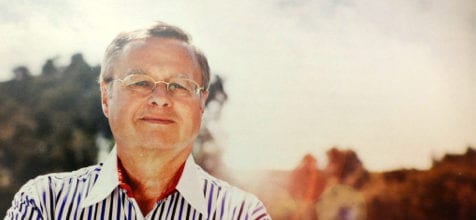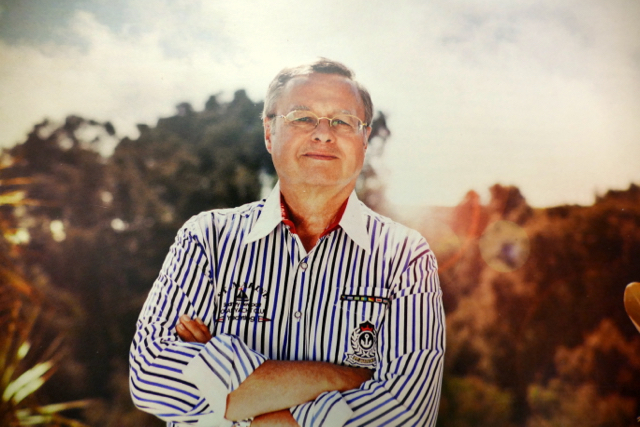Canada celebrates its 150th birthday in 2017. Our Q&A series on Monaco’s Canadian community starts with Dr Gervais Dionne, a researcher in medicinal chemistry who developed ground-breaking anti-HIV drug
ML: Can you share some details about the town you are from in Quebec?
GD: I was born in Saint-Jean-Port-Joli, a village of about 3,000 inhabitants located 100km east of Quebec City, on the south shore of the Saint Laurence River. I did most of my studies in Quebec City and in Montreal, and spent most of my working life around Montreal.
Montreal is the second largest city in Canada with a population of around 4 million – versus 6 million for Toronto – and is an academic and industrial centre with four universities and several research institutes, as well as many high tech industries including aerospace, electronics, software engineering, pharmaceuticals and telecommunication.
ML: What factor contributed in your choice of becoming a chemist?
GD: Early on in high school, I became very interested in the sciences, and I subscribed to “The Young Scientist” magazine and was fascinated by the world of nature sciences, the atom, molecules, the elementary and sub-particles … I got a chemistry kit as a Christmas gift from my parents. By following the guide I was able to conduct experiments, but was not able to understand what was going on. So I decided that I wanted to understand.
ML: Why did you choose research as a career?
GD: Early during my chemistry studies I got a scholarship that provided me the opportunity to spend a summer in a university research laboratory. It was in professor Bernard Belleau’s laboratory at the University of Ottawa. There I interacted with researchers (PhD students and post-doctoral fellows). I was trying to understand their work and was able to witness their passion towards their research. So I decided that was what I wanted to do with my life.
ML: Why have you chosen to specialise in medicinal chemistry?
GD: To design and build totally novel complex molecules is quite challenging and rewarding when the success is met. But I decided that it would be more rewarding for me to discover new molecules that would be useful to mankind, and especially that would potentially help to improve medical problems.
ML: Can you talk about your professional history?
GD: I got my first University degree in chemistry from the University of Montreal, then got a PhD in medicinal chemistry from Laval University in Quebec City, and then got a two-year scholarship as a post-doctoral fellow in a pharmaceutical company. I was hired by that company (Ayerst Laboratories) in Montreal as a Senior Researcher. There I conducted research projects in the field of cardiovascular and CNS (Central Nervous System).
ML: You discovered a new anti-HIV treatment, with fellow researchers Francesco Bellini and Bernard Belleau. Can you tell us about the drug-development company you formed with these two gentlemen, and your work on the anti-AIDS drug 3TC?
GD: In 1984, Ayerst Laboratories, an American company (which is now part of Pfizer pharmaceutical) decided to concentrate its research activities in the US. We were invited to move to New Jersey.
Among others, one of my colleagues, Francesco Bellini, and I decided not to move. Francesco Bellini, Bernard Belleau (then at McGill University) shared the same dream: to build an innovative research Canadian-based pharmaceutical company. The company was established in 1986 under the name of IAF BioChem International Inc, which became BioChem Pharma Inc.
Early on we decided to work on HIV infection/AIDS. It was a new disease and there was no satisfactory treatment. We were not too late to enter into the race. The first and only treatment was AZT (which was approved in 1987). AZT treatment was less than satisfactory because of poor efficacy and severe side effects.
We started a research program in 1987 aimed at discovering a molecule that would be at least as potent or more potent than AZT but without the nasty side effects. Bernard Belleau had a genius idea about a totally novel type of molecule. We decided to follow that path and in 1989 we found one molecule that was more potent in the test tube against HIV compared to AZT, but, more importantly, the molecule had very little toxicity compared to AZT or compared to other compounds, which were in development around the world at that time.
Because of the power of HIV and the rapid development of resistance it became obvious that the use of one drug would not be sufficient and in order to be successful one would need to use a combination therapy. After the evaluation of many combinations, the most promising results in test tube were obtained when AZT and 3TC were used together. A synergy of potency was observed and the development of resistances to the agents was delayed significantly. These results led us and our partner, Glaxo, to initiate large worldwide clinical trials. The results, which were astonishing, were released at the International AIDS Conference in Glasgow in November 1994.
The levels of the virus in blood cells of patients were reduced by 99% after one year of treatment with 3TC+AZT, compared with AZT monotherapy where the levels of the virus in the blood was reduced only by 11% after 6 months and 0% after a year. These results were a milestone in HIV treatment and confirmed that combination therapy was the way forward to keep the HIV at bay and thus changed the way HIV infection and AIDS was treated. 3TC was approved by the FDA in November 1995 and positioned itself as the cornerstone for the development of combination therapy.
Later, outstanding clinical trial results were obtained with the combination 3TC+AZT+IDV (Indinavir, a protease inhibitor developed by Merck). Levels of virus in blood cells of patients were reduced by 99.9%. This was another milestone; the beginning of tri-therapy, which is still today the standard of care for HIV infected/AIDS patients.
ML: How did this drug differ from others available?
GD: Like all other anti-HIV drugs 3TC targets a key enzyme of HIV, which is essential for its replication.
What makes 3TC unique is its “non-natural” chemical structure. Because of its “non-natural” structure 3TC does not affect human cells and is devoid of any side effect. So it can be combined with other anti-HIV drugs without additive toxicity.
Also, when mutation against 3TC develops, the resulting mutant virus is impaired, it does not replicate as rapidly and become more susceptible to other agents in the combination therapy.
ML: At what point during the research process did you realise that you had made a major discovery?
GD: The first event was in 1989 when the US National Cancer Institute (a division of the US National Institute of Health) conducted a comparative evaluation of all the anti-HIV molecules in development around the world, and concluded the 3TC was the most promising one, and was chosen for a collaboration between our two respective organisations. This, of course, was based on in vitro (test tube) results and there were a lot of unknowns in this early stage of development.
The second event was November 1994, with the results of the 3TC+AZT combination. Then we realised that this would make a huge difference for people living with HIV/AIDS.
ML: Can you describe the feeling of such a medical finding, that contributes to saving lives?
GD: The best reward in my life was when I met with patients who told me that when they were on AZT they were very sick in a hospital bed and had no hope, but under 3TC combination therapy they were back home, living an almost normal life, going to restaurants, cinema, travelling …
ML: How has the treatment of AIDS advanced since the eighties?
GD: The early tri-therapies were complex and difficult to take (many pills three times per day). Today tri-therapies are very simple: one pill once per day.
ML: What path did you take after this? What other projects have you been involved in?
GD: In 2004, I started another company with a BioChem Pharma colleague (Francois Legault) for the financial side of the operation. The company was ViroChem Pharma and we were conducting research in HIV, but mostly in Hepatitis C. Our team discovered several potent anti-HCV compounds, and one of them proved to be very powerful against the Hepatitis C virus in humans. The results attracted a lot of attention and interest in the industry and an American company acquired ViroChem Pharma in 2009.
ML: How did you end up in Monaco, and what do you appreciate about calling Monaco home?
GD: During our travels we enjoyed the Mediterranean “joie de vivre”. We initially moved to the South of France, but we learned more about Monaco and were particularly attracted by Monaco’s cultural life and multiculturalism that we were used to in Montreal. So, we moved to Monaco last November. We are in the middle of our integration in Monaco so it is too early for us to consider Monaco as “home”. But I am sure that we will rapidly feel at home in this great place.
ML: What do you miss about Canada? Do you socialise with Canadians?
GD: We have kept a country chalet in Canada and return every summer for two months to enjoy the Laurentide forest, lakes, rivers and wildlife.
ML: What does it mean to you to be Canadian?
GD: To be open and tolerant of others and proud to be from a country that often takes the position as a peacekeeper.
ML: Why are Canadians unique?
GD: Canadian culture is a mixture of British, French and American influences. Although French and English share official language status, Canada is very diverse, historically and ethnically. There is no single national culture: the melting pot of the neighbouring US is translated in Canada as something of a stew. Immigrants have both integrated into Canadian daily life, but continued to maintain some unique element of their ancestral homeland.
Article first published January 24, 2017.
READ ALSO: Canada 150: A Monaco Life Original Series, Father Walter Raymond
READ ALSO: Canada 150: A Monaco Life Original Series, Shale Wagman
READ ALSO: Canada 150: A Monaco Life Original Series, Maude Sabourin
READ ALSO: Canada 150: A Monaco Life Original Series, Stephan Bourgond
READ ALSO: Canada 150: A Monaco Life Original Series, Valerie Chiasson
READ ALSO: Canada 150: A Monaco Life Original Series, France Shapiro

